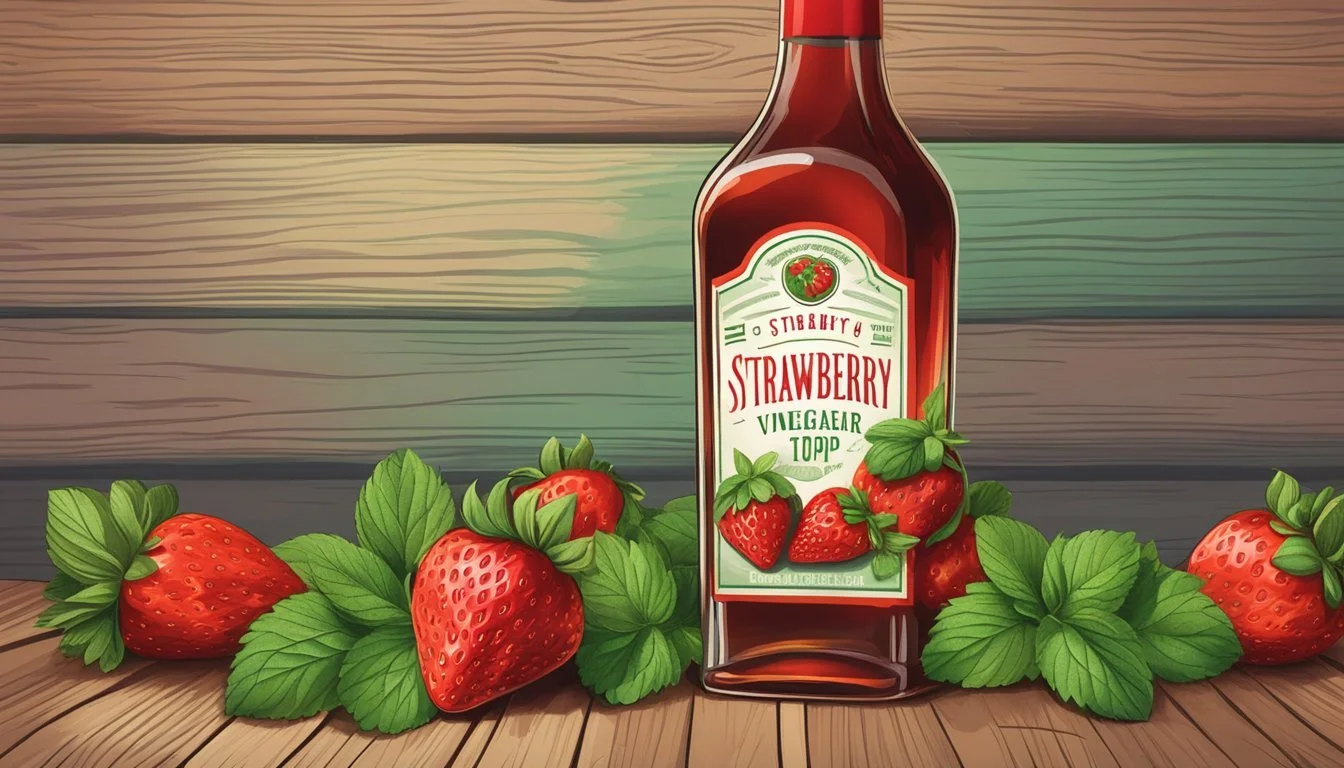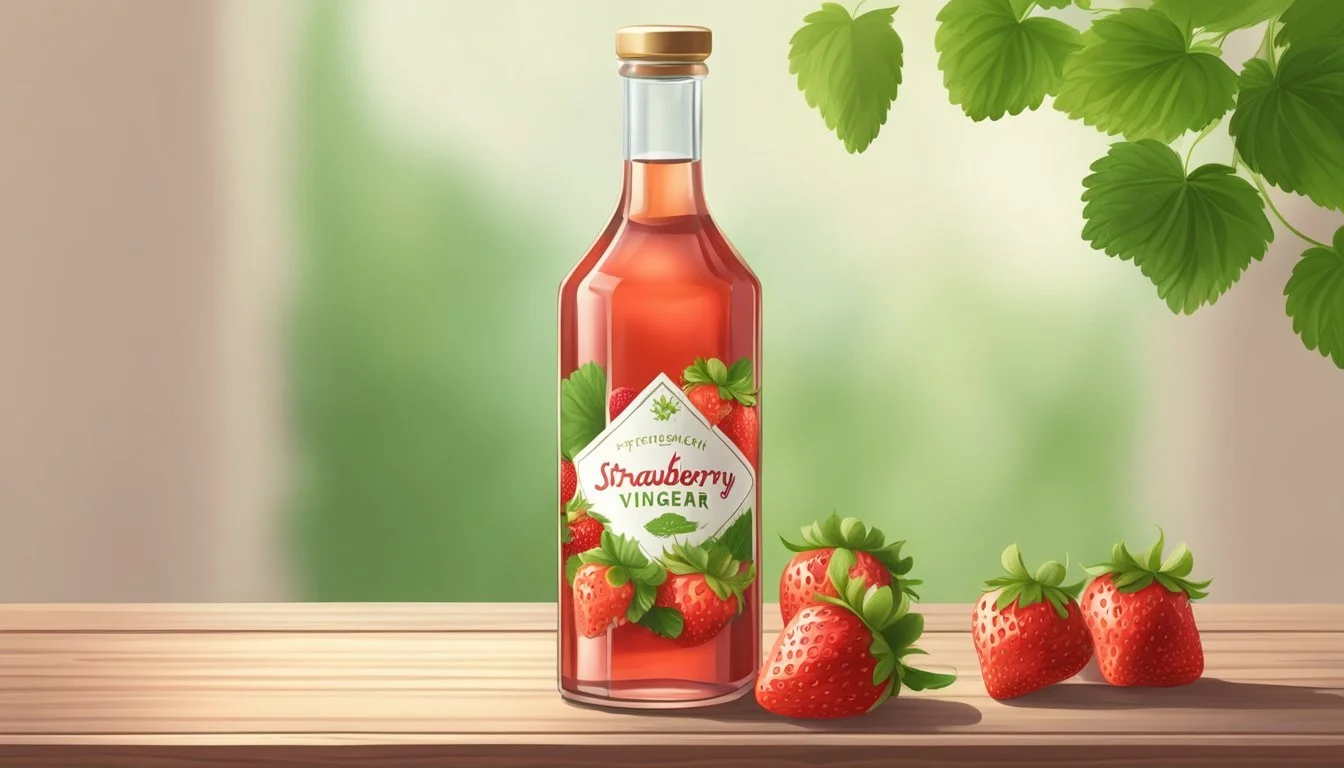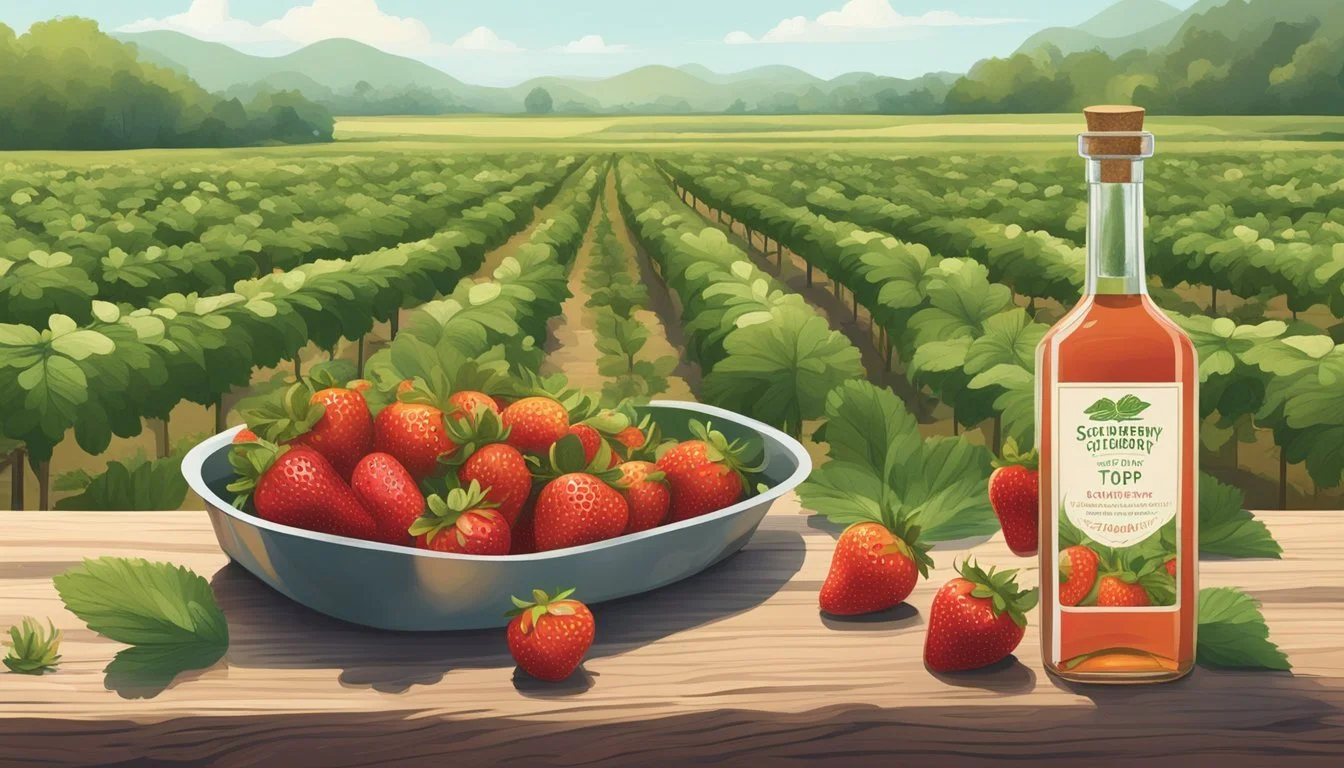Strawberry Top Vinegar
Elevate Your Dishes with This Unique Twist
Strawberry top vinegar is a unique and sustainable way to add a burst of fruity tang to a variety of dishes. This condiment is crafted from the often-discarded tops of strawberries, which lend a subtle berry flavor to the acidity of the vinegar. Ideal for salad dressings, marinades, or as a standalone vinaigrette, strawberry top vinegar is both a flavorful addition to recipes and a clever use of kitchen scraps that might otherwise go to waste.
Making strawberry top vinegar is simple and requires few ingredients, typically just the strawberry tops and a quality vinegar. The process involves allowing the flavors of the berries to infuse into the vinegar over the course of a few days. This not only produces a vinegar with a delightful flavor but also contributes to a waste-reducing practice in the kitchen.
As a versatile ingredient, the application of strawberry top vinegar is only limited by the cook's imagination. It pairs well with leafy greens, adds zest to sauces, and can even be used as a base for refreshing summer cocktails. By transforming the remnants of strawberries into an artisanal product, home cooks and chefs are able to capture the essence of the fruit in a unique, edible form.
What Is Strawberry Top Vinegar?
This condiment is crafted from the often-discarded tops of strawberries, transforming them into a tangy vinegar with a unique flavor. It serves as a versatile ingredient in many culinary contexts.
History and Origin
Strawberry top vinegar is not a new concept, with its roots tracing back to traditional practices of using fruit scraps to make vinegar. Its exact origin is difficult to pinpoint, but it aligns with the historical ethos of zero-waste in which all parts of food are used to their fullest potential.
Defining Strawberry Vinegar
Strawberry vinegar is a fruit-infused vinegar that is characterized by its fruity and tangy flavor profile. Unlike traditional vinegars, strawberry top vinegar is made specifically from the green leafy tops and the small amount of fruit flesh left attached after hulling strawberries.
The Role of Strawberry Tops
The strawberry tops play a crucial role in imparting a subtle berry essence into the vinegar. The tops are soaked in vinegar, usually a white or apple cider base, to create a condiment that is both aromatic and flavorful. The intrinsic properties of vinegar act as a preservative, allowing this concoction to be enjoyed long after the strawberries' season has ended.
Crafting Your Own Vinegar
Crafting your own strawberry top vinegar is a simple and rewarding process. By infusing the fruity flavors of strawberry tops into vinegar, home cooks can create a unique condiment that adds a tangy twist to various recipes.
Gathering Ingredients
To begin, the ingredients needed are:
Fresh strawberry tops (preferably organic to avoid pesticides)
Vinegar (apple cider or white wine vinegar are excellent choices)
A clean mason jar or glass jar
The recipe does not require added sugar, relying on the natural sweetness of the strawberries.
The Process Of Infusing
The infusing process involves a few clear steps:
Place the clean strawberry tops into the jar.
Pour enough vinegar over the tops to completely submerge them.
If using a metal lid, protect it from corrosion by placing parchment paper underneath; otherwise, use a plastic lid.
Allow the mixture to sit in a cool, dark place for 2-3 days for the flavors to properly infuse, which is the steeping process. The prep time is minimal, mainly entailing the cleaning and preparation of the strawberry tops, while the total time is essentially the steeping period of a few days.
Optimal Storage Methods
For optimal storage, consider the following:
Once steeped, strain the vinegar into a clean jar and discard the fruit scraps.
Store the infused vinegar in a cool, dark place or refrigerate to prolong its shelf life.
A container with a tight-fitting lid (glass or plastic) will prevent the vinegar from absorbing any odors.
Homemade strawberry top vinegar can bring a delightful zest to dressings, marinades, and even beverages. It's a practical way to use fruit scraps, promoting a no-waste kitchen.
Culinary Applications
Strawberry top vinegar lends a fruity tang to various dishes while promoting the use of food scraps, reducing food waste. Its versatility in the kitchen extends to salads, marinades, dressings, and desserts.
Enhancing Salads
Strawberry top vinegar can dramatically elevate the taste of a simple salad. Use it to create a strawberry vinaigrette by emulsifying the vinegar with olive oil, adding a pinch of salt and a sweetener to balance the tanginess. The result is a delightful dressing that brings out the freshness of green salads.
Creative Marinades and Dressings
Incorporate strawberry top vinegar into marinades to impart a subtle fruity note to proteins. Combine with herbs, garlic, and oil for a marinade that works especially well with chicken or pork. It also makes a base for dressings and dips, infusing them with a unique flavor that complements both raw and cooked vegetables.
Desserts and Sweets Integration
Not just for savory applications, strawberry top vinegar can add complexity to desserts. For example, it can be reduced to a glaze for drizzling over fruit tarts, incorporated into macerations for berries, or even used in baking to create moist cakes with a tangy twist.
Health and Nutrition
Strawberry top vinegar is gaining popularity as a tangy condiment, offering a unique take on traditional vinegars. It provides nutritional value in addition to its culinary uses. The following subsections will break down its nutritional profile and dietary considerations.
Nutritional Profile
Strawberry top vinegar, similar to other vinegars, is low in calories, typically providing about 5 kcal per tablespoon. It is virtually free of fat and protein, with nominal amounts tracing at approximately 0.03 g and 0.1 g respectively per serving. One tablespoon contains around 1 g of carbohydrates, which primarily constitutes of natural sugars. Although not significant in fiber, vitamin A, or iron, its vitamin C and potassium content can be slightly higher if infused with a substantial amount of strawberry tops.
Nutrient Amount per 1 tbsp Calories 5 kcal Total Carbohydrate 1 g Dietary Fiber 0 g Total Fat 0.03 g Protein 0.1 g Vitamin C Variable* Potassium Variable* Sodium 1 mg
*The content may vary depending on the amount of strawberry tops used.
Dietary Considerations
When used in moderation, strawberry top vinegar can be a health-conscious addition to one's diet. Given its extremely low sodium content, at 1 mg per tablespoon, it is a suitable choice for those on a low-sodium diet. Additionally, for individuals keeping an eye on their carbohydrate intake, this condiment is beneficial given its low total carbohydrate content. Those who are keen to avoid processed products can benefit from making strawberry top vinegar at home using organic apple cider or white wine vinegar, as it allows for control over the ingredients and avoids the potential addition of preservatives or additives found in some commercial products.
While it does not contribute significantly to the intake of calcium or dietary fiber, individuals can use strawberry top vinegar to enhance flavors in a calorie-conscious way. It is also versatile enough to pair with various dietary needs, from vegan to gluten-free diets.
It's essential to note that the health benefits hinge on the quality of the strawberries and vinegar used. Opting for organic materials and proper storage methods (using non-corrosive lids or parchment paper to prevent corrosion from metal lids) can maximize its health potential.
Variations and Substitutions
Making strawberry top vinegar can be a creative process, allowing one to experiment with a variety of vinegars and flavorings. This section explores how different bases, added flavors, and unconventional uses can diversify the condiment's portfolio.
Different Vinegar Bases
The choice of vinegar used as a base can significantly influence the taste and character of the final product. Here are some popular options:
Apple Cider Vinegar: Offers a fruity tang that complements strawberries well.
White Vinegar: A neutral choice that lets the strawberry flavor shine.
Balsamic Vinegar: Adds a rich, complex note to the infusion.
Champagne Vinegar: Brings a light and elegant tartness.
Red Wine Vinegar: Imparts a robust and full-bodied flavor.
Rice Vinegar: Suitable for a milder, slightly sweet tang.
White Balsamic Vinegar: Combines the gentle acidity of white vinegar with the sweet undertones of balsamic.
Malt Vinegar: It's less common but can introduce a unique, bold twist.
One could also try chive blossom vinegar or blueberry vinegar for a different flair.
Flavor Combinations
Spices and sweeteners can add depth or highlight the strawberry's natural sweetness. Here are some suggestions:
Spices: A pinch of black pepper or a cinnamon stick can introduce an intriguing spice note.
Sugars: Incorporate a tablespoon of honey or sugar to soften the vinegar's sharpness.
One can utilize alternative sweeteners like maple syrup or agave nectar as substitutes. Incorporating other fruit tops or herbs, like mint or basil, can create complex flavor profiles as well.
Non-Traditional Uses
Apart from dressing salads or flavoring drinks, strawberry top vinegar can find its place in unconventional applications:
Marinades: Infused vinegar can tenderize proteins and add flavor to meats and vegetables.
Cocktails: A splash can brighten up a cocktail, pairing excellently with spirits like vodka or gin.
Desserts: Drizzled over fresh fruit or ice cream for a savory twist.
Non-traditional vinegars such as strawberry top vinegar offer a refreshing departure from regular vinegar in many culinary contexts.
Strawberry Vinegar in Home and Beauty
Strawberry vinegar, beyond its culinary uses, holds valuable potential as a natural cleaning agent and an ingredient in homemade beauty recipes. Its acidity and pleasant aroma can be harnessed in various applications around the home.
Natural Cleaning Applications
Strawberry vinegar can effectively serve as a cleaner due to its acetic acid content, which is known for its disinfecting properties.
Glass Cleaner: Mix equal parts strawberry vinegar and water to create a streak-free glass cleaner.
Deodorizer: It can neutralize odors; simply add a bowl of vinegar to a smelly room for quick freshening.
Homemade Beauty Recipes
The use of homemade strawberry vinegar in beauty routines adds a fruity essence while tapping into the vinegar's natural benefits.
Hair Rinse: They can dilute strawberry vinegar with water (1 part vinegar to 2 parts water) and use it as a scalp treatment to remove product buildup and add shine to the hair.
Facial Toner: A gentle toner for the skin can be made by diluting the vinegar with water, which may help restore natural pH levels and soothe the skin.
Eco-Friendly Practices and Sustainability
Creating strawberry top vinegar is a practice in sustainability that reduces kitchen waste and utilizes organic ingredients to yield a flavorful condiment. These ecologically sound methods not only maximize the use of produce but also contribute to a healthier environment by minimizing the use of harmful substances like pesticides.
Reducing Kitchen Waste
Strawberry Season: During strawberry season, a significant amount of fruit scraps, specifically strawberry tops, are often discarded. Transforming these tops into vinegar effectively reduces food waste and extends the usability of the fruit.
Scrappy Cooking: Using strawberry tops, a part of the fruit that is typically thrown away, exemplifies a scrappy cooking approach. This practice supports waste-minimization efforts and promotes a more sustainable kitchen workflow.
Utilizing Organic Ingredients
Organic Strawberries: Choosing organic strawberries ensures that the fruit has not been exposed to synthetic pesticides or fertilizers. This choice supports environmentally friendly farming practices and results in safer, more sustainable ingredients.
Preservative Choice: Vinegar acts as a natural preservative, increasing the shelf life of food products without the need for artificial additives. Using vinegar to create condiments from food scraps, such as organic strawberry tops, is a health-conscious and sustainable method for both preservation and flavor enhancement.
Wrapping Up Strawberry Vinegar
As we draw our focus on the final stages of making strawberry top vinegar, one must appreciate the condiment's culinary flexibility and the expertise shared by food enthusiasts. It's not only a delightful way to utilize fruit scraps but also a testament to the innovative spirit of home cooks.
Final Thoughts on Versatility
Strawberry top vinegar shines in its versatility. It serves as a tangy base for vinaigrettes, melds beautifully with herbs to elevate sauces, and adds an unexpected twist to various dishes. This plant-based condiment finds its place in the pantry alongside other staple vinegars, yet stands out for the fruity nuance it brings to the table. A food blogger may attest to its adaptability, as it pairs well with a myriad of flavors across different types of cuisine.
Pro Tips
When making strawberry top vinegar, consider these suggestions to enhance both yield and preparation:
Yield: To maximize output, ensure that the strawberry tops are fully submerged in vinegar, which will vary depending on the size of your jar and the amount of scraps available.
Preparation: Sterilize the jar before use to prevent spoilage. For a more intense flavor, one might let the vinegar infuse for an extended period, up to a week, tasting periodically.
Remember, patience and attention to detail can substantially influence the quality of this homemade condiment.







